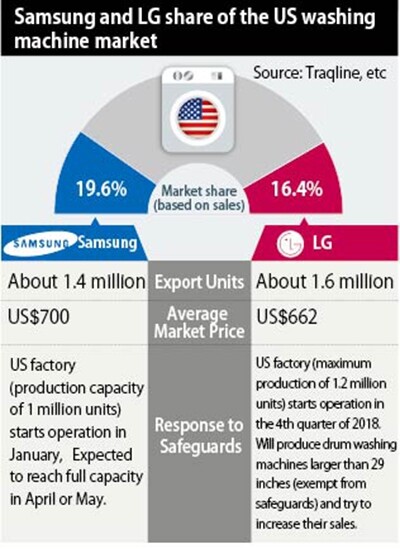hankyoreh
Links to other country sites 다른 나라 사이트 링크
[News Analysis] Trump administration’s trade safeguards portend a US trade war against Asian countries

US President Donald Trump’s decision on Jan. 22 to activate safeguards (emergency import restriction measures) against solar cells and modules and washing machines manufactured by foreign companies such as Samsung and LG is only the prelude to a trade war against Asian countries such as South Korea and China.
First of all, the US Commerce Department recently submitted to the White House the results of an investigation into increasing imports of steel and aluminum from China and other countries based on Section 232 of the Trade Expansion Act. Section 232 authorizes the blocking of imports that investigators have found to endanger national security, which gives it a reputation as being one of the toughest protectionist measures available.
Trump must decide whether to impose import restrictions within 90 days of receiving the report. “President Trump could announce related measures as early as his State of the Union address and press conference on Jan. 30,” said one trade expert in Washington.

The fact that the results of the investigation into steel and aluminum were submitted to Trump early this year is highly symbolic. This issue had been delayed since last summer because of considerable disagreement inside the government, but this apparently resulted in a victory for hardliners on trade. These hardliners have argued that relying on foreign sources for security-related materials could be a liability in times of war, but US Secretary of Defense James Mattis stubbornly resisted this argument out of concern that warships and other weapons could become more expensive to produce.
If the US adopts trade remedies against steel, many believe, South Korea might not be able to avoid the fallout either. One point of view in the US is that the recent increase in exports of South Korean-manufactured oil country tubular goods to the US constitutes indirect dumping of low-cost Chinese steel. This could lead to a situation similar to the collateral damage inflicted on South Korean products by the US safeguard aimed at Chinese solar panels.
The Office of the US Trade Representative’s investigation into Chinese violations of intellectual property rights, which was launched by an executive order given by Trump in Aug. 2017, is reportedly entering its final stage. Trump said during an interview with Reuters on Jan. 17 that the US would soon be announcing sweeping fines against China for intellectual property violations.
There’s no disagreement that Trump’s trade protectionism will move into high gear in time for the midterm congressional elections, which will be held this November. Washing machines, steel and solar panels are all directly linked to the white working-class voters who constitute Trump’s base, and are geographically centered in the Rust Belt.
Furthermore, trade remedies are a politically convenient option, since the president is given considerable authority in this area and can make quick decisions even without Congress’s cooperation. Some analysts think that the Trump administration felt it could afford to launch a trade war with China, which it believes has exhausted its leverage over North Korea and has nothing else to offer.
In a statement released on Jan. 23, Wang Hejun, director of the Trade Remedy and Investigation Bureau for China’s Ministry of Commerce, expressed strong displeasure, describing the US’s measures as “excessive protection for domestic industry” and “an abuse of trade remedies.”
“The prevailing mood is that China has no choice but to retaliate commercially against the US, matching fines for fines and tariffs for tariffs,” said a source who is familiar with the situation in Beijing. This is leading to the prediction that the US and China will keep probing to see how much the other is willing to take.
By Kim Oi-hyun, Beijing correspondent and Yi Yong-in, Washington correspondent
Please direct questions or comments to [english@hani.co.kr]

Editorial・opinion
![[Editorial] Penalties for airing allegations against Korea’s first lady endanger free press [Editorial] Penalties for airing allegations against Korea’s first lady endanger free press](https://flexible.img.hani.co.kr/flexible/normal/500/300/imgdb/original/2024/0502/1817146398095106.jpg) [Editorial] Penalties for airing allegations against Korea’s first lady endanger free press
[Editorial] Penalties for airing allegations against Korea’s first lady endanger free press![[Editorial] Yoon must halt procurement of SM-3 interceptor missiles [Editorial] Yoon must halt procurement of SM-3 interceptor missiles](https://flexible.img.hani.co.kr/flexible/normal/500/300/imgdb/child/2024/0501/17145495551605_1717145495195344.jpg) [Editorial] Yoon must halt procurement of SM-3 interceptor missiles
[Editorial] Yoon must halt procurement of SM-3 interceptor missiles- [Guest essay] Maybe Korea’s rapid population decline is an opportunity, not a crisis
- [Column] Can Yoon steer diplomacy with Russia, China back on track?
- [Column] Season 2 of special prosecutor probe may be coming to Korea soon
- [Column] Park Geun-hye déjà vu in Yoon Suk-yeol
- [Editorial] New weight of N. Korea’s nuclear threats makes dialogue all the more urgent
- [Guest essay] The real reason Korea’s new right wants to dub Rhee a founding father
- [Column] ‘Choson’: Is it time we start referring to N. Korea in its own terms?
- [Editorial] Japan’s rewriting of history with Korea has gone too far
Most viewed articles
- 11 in 3 S. Korean security experts support nuclear armament, CSIS finds
- 2Months and months of overdue wages are pushing migrant workers in Korea into debt
- 3Bills for Itaewon crush inquiry, special counsel probe into Marine’s death pass National Assembly
- 4Trump asks why US would defend Korea, hints at hiking Seoul’s defense cost burden
- 5[Reporter’s notebook] In Min’s world, she’s the artist — and NewJeans is her art
- 6[Editorial] Penalties for airing allegations against Korea’s first lady endanger free press
- 7S. Korea discusses participation in defense development with AUKUS alliance
- 8[Column] Can Yoon steer diplomacy with Russia, China back on track?
- 9Vietnamese war victims speak of sexual violence by S. Korean troops for the first time
- 1060% of young Koreans see no need to have kids after marriage